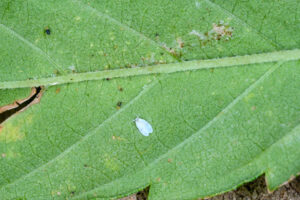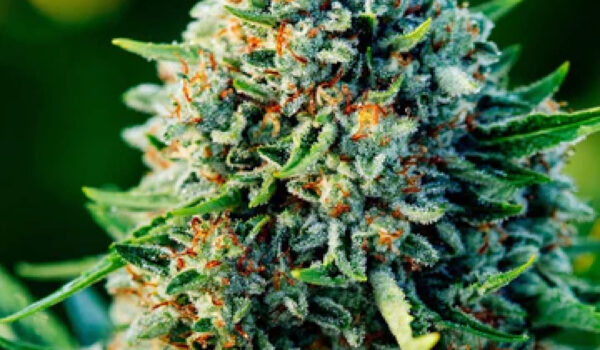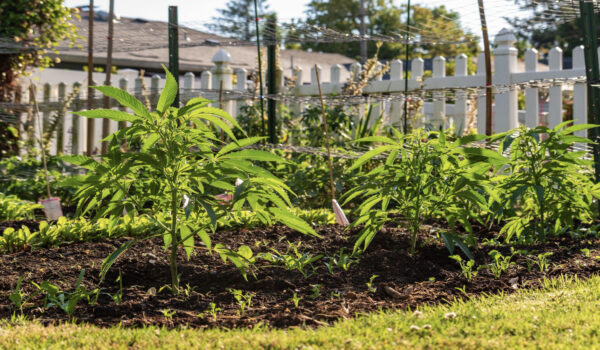by Rincon-Vitova Insectary

Whiteflies are not flies but are related to honeydew producing pests like aphids, scales, mealybugs. They have piercing, needlelike mouthparts to suck sap from plants. Large populations can cause plant distortion, discoloration, yellow or silvering of leaves, leaves to fall off plants, and serious crop losses. Some whiteflies transmit viruses to certain vegetable crops. Most common species, Greenhouse and sweet potato (=tobacco/bemesia tabaci) Silverleaf (Bemesia agentifolii) whitefly, have a wide host range. Whiteflies breed all year round in warmer parts of California, moving from one host to another as plants are harvested or dry up.
Identification
Adults are 1/16 inch long moth-like insects with yellowish bodies, short antennae, and white wings.
Nymphs are wingless, flat, oval-shaped and almost resemble scale insects.
All stages feed by sucking plant juices from leaves and excrete honeydew, which often attracts ants.
Life Cycle
Females lay tiny oblong eggs on the undersides of leaves, which hatch in 5-10 days.
1st nymphal stage (crawler) is barely visible even with a hand lens.
2-4th nymphal stages are immobile, oval, and flattened, with greatly reduced legs and antennae, like small scale insects. The winged adult emerges from the last nymphal stage (sometimes called a pupa. Not complete metamorphosis).
Egg to adult is approximately 25 days. Adults may live for 1-2 months. Many generations occur per year.
Monitoring
Watch for clouds of tiny white insects that flutter around plants when disturbed.
Check for tiny nymphs on the underside of leaves.
Sticky honeydew -and a covering of black sooty mold could also be present.
Yellowing, silvering, or drying leaves that have whitefly nymphs on them are an indication of a whitefly infestation.
Deposits of white wax can be present with certain whiteflies.
Look for signs of parasitization by mini-wasps: Look for circular holes in nymphs or a change in color.
Round/ oval exit holes indicate parasitism, versus T-shaped exit holes which are a sign of healthy adult whiteflies.
Cultural Practices
Quarantine & Inspect new plants.
Sanitation.
Use reflective mulch, which repel whiteflies while plants are small.
Remove mulches when plants get large and temperatures get hot.
Hang sticky-coated yellow traps: 1 card per 500 sq ft. Higher densities of traps pinpoint infestations more accurately
Hang cards with the sticky side facing plants and out of direct sunlight.
DIY sticky traps: 1/4-inch plywood or masonite board painted bright yellow, mounted on pointed wooden stakes.
DIY adhesive: one-part petroleum jelly or mineral oil and one-part household detergent.
Can be easily cleaned off with soap & water, (a commercial solvent must be used to remove other adhesives). Periodic cleaning is essential to remove insects and debris from the boards and maintain the sticky surface.
Vacuuming
Hose adults off plants with a strong stream of water.
Prune out isolated infested leaves when you first detect them. Remove infested plants.
Promptly destroy infested annuals when the flowering or fruiting ends.
Habitat: Eggplant & bean plants as trap crops. Cucumber traps for B. tabaci (sweet potato, tobacco & cotton are whitefly magnets).
Nasturtiums, basil & marigolds repel whitefly
Evergreen perennial plants can host high pops of whitefly in winter, consider removing these to lower overwintering whitefly populations.
Protect native beneficials that help reduce whitefly numbers.
Prevent dusty conditions since dust disrupts beneficials.
Suppress ants, which protect whiteflies from natural enemies.
Use a 1% soap solution, weekly, directing the spray onto new leaves to kill adult whiteflies and crawler stages.
Insecticidal soap: fatty acid salts weaken the cuticle (exoskeleton), and won’t leave a harmful residue.
To help the soap penetrate the insects’ outer shell, mix 1 Tbs of isopropyl alcohol to 1 Qt of the spray.
Insecticidal soaps & oils are harmful only whitefly directly sprayed.
Good coverage, including the underside of leaves, is essential.
Infestations on the lowest leaves are most difficult to reach
Use soaps or oils when plants are not drought-stressed and when temperatures are under 90°F to prevent possible “burn.”
Early evening, (enough light to safely apply but sun is not shining directly on plants), may be a good time to spray.
Repeat applications may be necessary.
Neem oil – not for flowering plants (will leave smell/taste on buds)
Neem Oil (Azadirachtin): mimics IGRs: primarily kills immature insects (they fail to complete molts). It also acts as an antifeedant & repellant. Neem is less effective on aphids & some grasshoppers. Neem also breaks down in water – don’t mix more than needed. It persists 4-8 days as foliar spray, and weeks if drenched. Neem does not harm foraging bees.
Avoid using pesticides: Pyrethroids (bifenthrin, cyfluthrin, fluvalinate, and permethrin), Organophosphates (acephate), Carbamates (carbaryl), Neonicotinoids (imidacloprid). These materials are highly toxic to natural enemies and pollinators.
*Even the most toxic insecticides are only partially effective against whiteflies.
Bio-Control
Beauveria bassiana (for aphids, thrips, WF)
68-86 °F >92% RH
An entomopathogenic fungus wide host range, including soft-bodied beneficials
Best for sap-sucking & chewing insects
Spores germinte on insects – kill in 2-10 days
Some strains have 3-7 day residual activity
Weekly applications can prevent insect population explosions
Metarhizium anisopliae
Fungal pathogen penetrates skin, enters spiracles
Infected insects stop feeding and die in 4-10 days
whiteflies and aphids (other strains for thrips, beetles)
Best in high humidity and moderate temps: 75-82°F
Application Rates: Application Rates may vary among different commercial products. Read labels carefully.
40-80 oz per 100 gallons of water as a drench
8–64 oz per 1 acre as a foliar spray
Paecilomyces fumosoroseus
Optimal conditions >68% RH and 72-91°F
Fungal pathogen that infests WF through the skin
Some strains also kill spider mites, aphids, and thrips (sometimes ladybeetles)
Spores kill WF in 4-5 days
Compatible with other fungi & predatory mites
Application Rates: Application Rates may vary among different commercial products. Read labels carefully.
Greenhouses only: 4-6 oz per 11,000 sq ft
Generalist Predators:
Hippodamia convergens
Ladybugs – will feed on eggs and immature stages both as adults and larvae.
Often leave after released
Application Rates: 1 beetle per sq ft.
Reapply if necessary
Chrysoperla rufilabris
Green Lacewing – generalist
Wingless predator for 2-3 weeks
Will target all life stages
Application Rates: 1,000 eggs per 2,500 sq ft or 5,000-10,000 per acre
Eggs on Cards: hang 1-2 units/bush, 1-5 units tree
Pre-hatched Larvae: 20/bush, 100/tree
Reapply every two weeks to suppress populations, monthly for maintenance
Specific Predators/Parasites:
Amblyseius swirskii
Beneficial generalist predatory mite
Consumes whiteflies, thrips & mites as well as pollen or plant exudates.
Adapted to warmer/humid climates and may be less effective in cooler conditions and at reduced relative humidity.
Prefers immature stages of greenhouse and silverleaf whiteflies
Does not diapause – used throughout the season provided daytime temps regularly exceed 72°F. Humidity > 70%
Avoid using with A. aphidimyza or P. persimilis
Application Rates: fast release: 2-5 mites per sq feet
Reapply biweekly
Slow release: 1 sachet per 3-5 plants, depending on size/touching. Remove after 6 weeks
Encarsia formosa
Tiny parasitic wasp that parasitizes Greenhouse, Silverleaf, and Sweet potato whiteflies
For release in greenhouse situations; not for outdoor: preventive parasite & not well adapted for temperate zones.
Optimum conditions are temperatures over 68°F, high light levels (7300 lux) and relative humidity 50-70%.
When daytime temperatures are less than 64°F Encarsia activity is sharply reduced, making them less effective.
Important to hang the cards from lower leaves in the shade as Encarsia tend to fly upward
Avoid wetting them while watering
Do not use Encarsia if high whitefly populations are already established = Delphastus
Compatible with Delphastus, Dicyphus, and Eretmocerus
Application Rates:
Any WF seen on sticky cards, apply at a rate of 0.2 per 10 sq ft, weekly.
When de-leafing plants, do not remove leaves that have significant numbers of black (parasitized) whitefly scales unless these have emerged. If leaves must be pruned from plants, retain them in the greenhouse, under the plants, until the wasps
have emerged (1 to 2 weeks).
Eretmocerus eremicus
Wasp feeds on younger larval stages and parasitizes the 2nd larval stage of tobacco, silverleaf, sweetpotato whitefly
Performs well in warmer climates and in fluctuating temperatures Optimum temperature range is 77-84°F.
Minimum effective temperatures are 50 ºF night and 65 ºF day.
Use at low doses to prevent whitefly establishment & is likely to last all season long.
Blister packs make product clearly visible and allow the grower to judge quality and emergence more easily.
Parasitized whitefly turn yellow, rather than black.
Application Rates:
Begin weekly releases in April or when temps > 75°F at a rate of 1 Eretmocerus/10 sq ft
In May, increase to 2 Eretmocerus/10 sq ft.
Delphastus catalinae (= D. pusillus)
Specialized whitefly predator in the lady beetle family.
Adults and larvae feed on whitefly eggs and immature stages.
If food is scarce, they will also feed on other small arthropods, and will cannibalize their own species.
Delphastus avoids parasitized whiteflies, & is compatible with Encarsia spp. and Eretmocerus spp.
Tends to feed in high density whitefly populations, while parasites do best at lower densities
Delphastus adults prefer feeding on whitefly eggs.
Optimum conditions are moderate to high temperatures 61-90ºF
Do not fly at temperatures below 55 ºF.
Delphastus do not enter diapause under short-day conditions, therefore remain active all season.
Application Rates:
Release 1-2 beetles/10 sq ft
Reapply weekly, for 3-4 weeks or until established in all infested areas.
Summary of Strategies for whiteflies
Quarantine, Sanitation
Remove infested plants/foliage
Yellow sticky cards for monitoring
Ant control!
Water/soapy water knock down sprays
Neem Oil
Beauveria bassiana
Metarhizium anisopliae
Indoor crops:
Encarsia releases preventively
Eretmocerus at first sign of WF
Delphastus for well established populations
Outdoor crops:
Lacewing releases preventively
Delphastus possibly for well established populations


